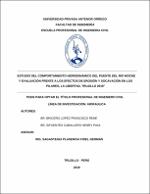Estudio del comportamiento hidrodinámico del puente del rio Moche y evaluación frente a los efectos de erosión y socavación en los pilares, la libertad, Trujillo 2019

View/
Download
(application/pdf: 7.542Mb)
(application/pdf: 7.542Mb)
Date
2019Author(s)
Briceño López, Francisco René
Sifuentes Caballero, Henry Paúl
Metadata
Show full item recordAbstract
La importancia de un estudio sobre los efectos de la erosión y socavación frente a cargas de agua provenientes de máximas avenidas conlleva a la investigación de las condiciones hidrodinámicas desarrolladas en el entorno de la estructura, Puesto que existe la necesidad de conocer la respuesta del cauce frente al emplazamiento de una estructura en él y cómo ésta es, así poder determinar si es vulnerable o no al efecto de socavación.
Mediante la creación de modelos de dinámica de fluidos computacional, se construyó 2 modelos, un modelo en 2 dimensiones empleando IBER 2.3.4 y un modelo numérico en 3 dimensiones utilizando la interfaz del software FLOW3D, con el cual se compiló la versión digital tanto del terreno como del puente creando una simulación a detalle del entorno donde se desarrolla la realidad problemática, también determinados los parámetros hidrodinámicos del puente y por ende su comportamiento frente a las cargas dinámicas de agua, apoyándonos de los estudios de topografía, hidrología y mecánica de suelos obteniendo así la pendiente del terreno, caudal circundante en el cauce y la clasificación del suelo respectivamente. Así poder evaluar los resultados obtenidos de los parámetros hidrodinámicos existente en el emplazamiento de los puentes en el cauce obteniendo los siguientes resultados: Bidimensional - Tirante: 4.12 - 4.95m; velocidad: 7.98 – 8.88 m/s; erosión 1.02 – 1.93; acumulación de sedimentos: 2.16 – 0.79 m; transporte de sedimentos: 0.096 – 0.064 m2/s; Régimen de flujo: Supercrítico predominante, Tridimensional – Tirante máximo en el cauce: 3.84m; velocidad 11.435 – 22.87 m/s; Froude: supercrítico Predominante, riberas f= 0.83 – 0.67. The importance of a study on the effects of erosion and scouring against water loads from maximum floods leads to the investigation of the hydrodynamic conditions developed in the environment of the structure, since there is a need to know the response of the riverbed in front of to the location of a structure in it and how it is, in order to determine if it is vulnerable or not to the effect of undermining.
Through the creation of computational fluid dynamics models, 2 models were built, a 2-dimensional model using IBER 2.3.4 and a numerical model in 3 dimensions using the FLOW3D software interface, with which the digital version of the model was compiled. ground as of the bridge creating a simulation to detail the environment where the problematic reality is developed, also determined the hydrodynamic parameters of the bridge and therefore its behavior in front of the dynamic loads of water, supported by the studies of topography, hydrology and soil mechanics thus obtaining the slope of the terrain, the surrounding flow in the channel and the classification of the soil respectively. Thus, we can evaluate the results obtained from the hydrodynamic parameters existing at the site of the bridges in the channel, obtaining the following results: Bidimensional - Strut: 4.12 - 4.95m; speed: 7.98 - 8.88 m / s; erosion 1.02 - 1.93; sediment accumulation: 2.16 - 0.79 m; sediment transport: 0.096 - 0.064 m2 / s; Flow regime: Supercritical predominant, Three-dimensional - Maximum tension in the channel: 3.84m; speed 11.435 - 22.87 m / s; Froude: Supercritical predominant, banks f = 0.83 - 0.67
Collections
- Ingeniería Civil [1260]

